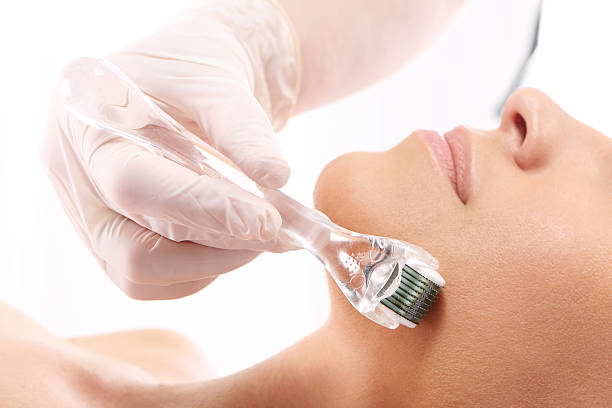Microneedling, also known as collagen induction therapy, is a cosmetic procedure that involves puncturing the skin with tiny, sterile needles. The process stimulates the body’s natural wound healing process, leading to increased collagen and elastin production, which are essential for maintaining youthful, healthy-looking skin.
Here’s the science behind microneedling:
- Stimulation of Collagen Production: When the tiny needles puncture the skin, it creates controlled micro-injuries. In response, the body’s natural healing process is triggered, leading to the production of new collagen and elastin. Collagen is a protein that provides structure to the skin, while elastin allows the skin to stretch and bounce back. As we age, the production of collagen and elastin decreases, leading to the formation of wrinkles and sagging skin. Microneedling helps to stimulate the production of these proteins, resulting in smoother, firmer skin.
- Increased Absorption of Topical Products: Microneedling creates micro-channels in the skin, which allows for better penetration and absorption of topical products such as serums, creams, and growth factors. This enhances the effectiveness of skincare products, as they can penetrate deeper into the skin where they can exert their effects more efficiently.
- Improvement of Skin Texture and Tone: Microneedling can help improve the overall texture and tone of the skin by reducing the appearance of scars, hyperpigmentation, and uneven skin tone. The micro-injuries created during the procedure stimulate cell turnover and promote the regeneration of new, healthy skin cells.
- Reduction of Fine Lines and Wrinkles: By stimulating collagen and elastin production, microneedling can help reduce the appearance of fine lines and wrinkles, resulting in smoother, more youthful-looking skin.
- Treatment of Various Skin Conditions: Microneedling has been shown to be effective in treating various skin conditions, including acne scars, stretch marks, enlarged pores, and rosacea.
Overall, microneedling works by harnessing the body’s natural healing process to rejuvenate the skin, improve its texture and tone, and address various skin concerns. It is considered a safe and effective cosmetic procedure when performed by a trained professional. However, it’s essential to consult with a dermatologist or skincare specialist to determine if microneedling is suitable for your skin type and concerns.

Is microneedling scientifically proven?
Here are some key findings from scientific research on microneedling:
- Collagen Production: Several studies have shown that microneedling stimulates collagen production in the skin. For example, a study published in the Journal of Cutaneous and Aesthetic Surgery found that microneedling significantly increased collagen and elastin levels in the skin, leading to improvements in skin elasticity and firmness.
- Wrinkle Reduction: Research has demonstrated that microneedling can effectively reduce the appearance of wrinkles and fine lines. A study published in the International Journal of Dermatology reported significant improvements in wrinkle severity and overall skin appearance following microneedling treatments.
- Acne Scarring: Microneedling has been shown to be particularly effective in reducing the appearance of acne scars. Multiple studies have found that microneedling can lead to significant improvements in acne scar depth, texture, and overall appearance.
- Hyperpigmentation: Microneedling has also been studied for its ability to improve hyperpigmentation and uneven skin tone. Research has shown that microneedling treatments can help reduce the appearance of dark spots and pigmentation irregularities by promoting the turnover of skin cells and enhancing the penetration of lightening agents.
- Safety and Efficacy: Overall, studies have demonstrated that microneedling is a safe and effective cosmetic procedure when performed by trained professionals. Side effects are generally mild and temporary, including redness, swelling, and minor discomfort, which typically resolve within a few days to a week after treatment.
While microneedling has been scientifically proven to be effective for various skincare concerns, it’s essential to note that individual results may vary, and multiple treatment sessions may be needed to achieve optimal results. Additionally, it’s crucial to undergo microneedling treatments under the supervision of a qualified dermatologist or skincare professional to ensure safety and efficacy.
